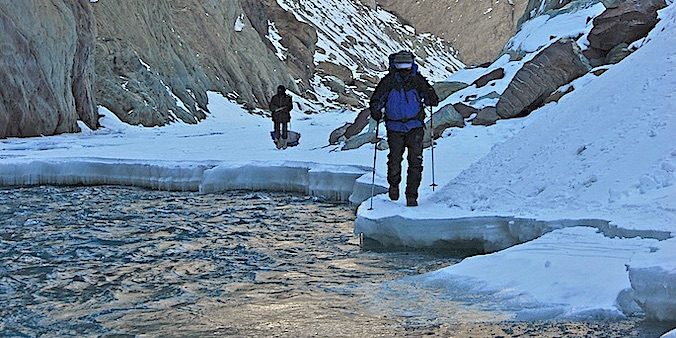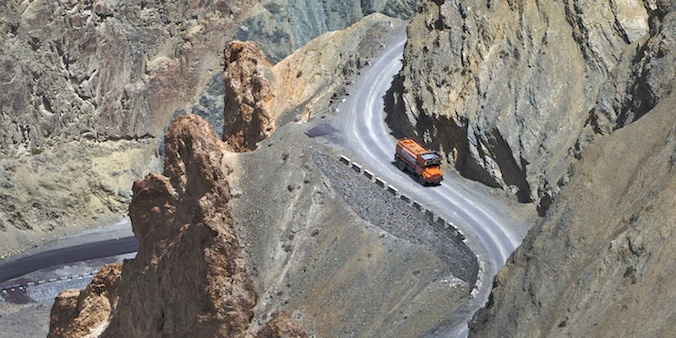LADAKH - THE CHADDAR ICE TREK
Tour - 15 days/ 10 days trekking
LADAKH - THE CHADDAR ICE TREK
Tour - 15 days/ 10 days trekking
About LADAKH & ZANSKAR
Ladakh is a part of the Indian Himalayas It is located between the Kunlun mountain range in the north and the main Himalayas to the south. Although part of India now, and earlier of the princely state of Kashmir, Ladakh has been an independent kingdom for almost 900 years.
Ladakh is well-known for its starkly beautiful mountain scenery. As a result of its location in the rain shadow of the main Himalayan Range its climate is extremely dry, and due to the high altitude – most valleys are situated at 3300m or higher – winters can be extremely cold. Summers, however, are generally pleasant if not warm and sunny. Ladakh is inhabited by a mix of Indo-Aryan and Tibetan people. Especially the latter, with their colourful buddhist culture, have given the region the nickname of ‘Little Tibet.’
Ladakh in the narrower sense is the Indus Valley with adjacent areas. It is bordered by two mountain ranges: in the northeast by the Ladakh Range, in the southwest by the Zanskar Range. The area around the capital Leh, and further upstream towards Tibet, is referred to as Upper Ladakh. Lower Ladakh is the area further downstream to Kargil, where the Indus enters Pakistan.
The remoter areas of Zanskar, Nubra and Rupshu are now seen as regions of Ladakh. In the past, these areas were sometimes part of Ladakh, sometimes not. They can be visited from Leh by car or on foot. The latter would be your means of transport, if you are up to it. Because, while jeep trips in Ladakh are very rewarding indeed, trekking will give you an even in-depth experience of the land and the people, with the added bonus of a total renovation of body and soul.
Ladakh can be reached by air or overland. The overland route is only possible between May / June and early October. This tour takes you by train and car to Ladakh through the regions Kinnaur and Spiti, both in the state of Himachal Pradesh. Kinnaur is the area around the Sutlej, one of the four large rivers that originate on the flanks of holy Mt. Kailash in Tibet. It is an area of steep mountain sides and a culture that interestingly seems to hover in between the two great cultures of India (predominantly Hindu) and Tibet (Buddhist).
Zanskar lies wedged in between the Himalayan Range and the Zanskar Range, which separates it from Ladakh proper in the Indus Valley. It is an isolated area that can only be reached by road for four to five months of the year, in a journey of two or three long days on partly unpaved roads.
Thanks to its isolated location the changes that have happened in Ladakh are happening slower or not yet at all here. The Zanskaris are a relaxed people with both feet on the ground, the majority of them still living of self-sufficient agriculture. Barley is the staple food, the basis for flour, bread, thukpa (stuffed soup) and chang (beer). In the summer some rupees are earned in temporary restaurants, guiding tourists or hiring out pack horses.Region
Ladakh
(India)
Best Time
February
No. of Days
15 days/ 10-day trek
Trip Character
Winter trek
Trip Character
Trekking tour
Level: 3/4
Sleeping Altitude
3300 - 4500 m.
Price
INR XXX/ $ XXX
ABOUT THIS TOUR
Trekking through wintry Himalayas is an experience that is hard to beat. Those who have done it, hoard a well-kept secret: it is a fantastic, mesmerising experience. On this trek we throw in an extra element: frozen rivers.
On this trek we walk from Ladakh to the isolated area of Zanskar. Not far from Leh, the capital of Ladakh we step onto the ice of the frozen Zanskar River, which is a wide and raging river in summer. Then we follow the river, most of the time walking on the ice, to the small hamlet of Lingshed, in Zanskar. We return the same way.
Walking, shuffling and sliding on the ice amidst snow-covered mountains and frozen waterfalls is, obviously, a cold affair but a mesmerising one as well. The ice itself is never the same, changing in colour and texture all the time. In many places the river doesn’t freeze over completely and here we have to be very careful not to falling to the cold, raging water. Sometimes we have to scramble or climb the steep slopes of the gorge to work our way around an iceless spot.
Although this trek does not require alpine skills, it is important that you are sure-footed on ice, snow, rocks and scree. As you will be sleeping in tents, experience with winter trekking and winter camping is strongly preferred. At temperatures of minus 15 to 20 this is obviously not a comfortable affair. Warmth has to be provided by your own body and retained by a very good sleeping bag.
YOUR custom-made TRIP
The tour described here, as well as the other ones on our website, are mainly meant as suggestions. We would be happy to offer you a travel proposal that fully meets your personal demands and expectations. That means that you choose where you want to go, what level of accommodation and type of transport you want and what activities you prefer.
Please let yourself be inspired by this and other trips on our website and then drop us a line (or call us up) to explain your travel wishes. We will be happy to help you put together the perfect trip. You can reach us over e-mail, Messenger, Whatsapp or mobile phone.
EXTENSIONS & VARIATIONS
Apart from the tour as described here, you could consider the following add-ons and changes:
- After reaching Leh do a 6-day exploration jeep tour to Nubra Valley, Shyok and Pangong Tso.
- Do a trek in in the Indus Valley near Leh. For instance the easy but rewarding 4-day Sham Trek See here. You sleep in homestays where you get to meet the Ladakhis up-close. Or the more demanding 5-day trek from Chilling to Lamayuru. On this trek you sleep in trekkers tents while a walk-along cook prepares your meals. You walk longer distances, climb higher passes but the rewards are even better views, more authentic villages. See here.
- Spend a day rafting on the Indus. There are different grades available, so there is the easy but fun to do level as well. Professional oarsmen will be with you in any case. You will be picked up from your hotel and dropped off there again at the end of the day, a pic-nic lunch is included.
- Continue the trip after visiting the Indus Valley and Nubra in the direction of Kargil. Then, cross the Himalayan Range again, southward to Srinagar (Kashmir). Here, you can end your tour relaxing a couple of days on a houseboat on idyllic Dal Lake. This is our tour Ladakh full circle.
ITINERARY
-
Day 1: Flight Delhi - Leh
The flight from Delhi to Leh takes only 1 hour but on a clear day, is breathtaking. It takes you over Himalayan Range and the Zanskar Mountains, all covered in snow. Stepping down from the aircraft you may feel the altitude, but even if you don’t, it is very wise to take the rest of the day off. Stay at the hotel or at best walk around Leh bazar. Altitude: 3500m. -
Day 2 & 3: In Leh
If you wake up today without a headache you may consider yourself fit to go on not too strenuous walks/excursions in and around Leh. Else it is better to stay at the hotel another day. Altitude: 3500m. -
Day 3: Leh - Chilling & start Ice Trek (3 h drive, 4 h walking)
After breakfast jeeps will take us to the beginning of the trek. After arranging our luggage by our porters we’ll start off on the ice. Altitude 3500 → 3200m. -
Day 4 - 13: Ice trekking
During the trek you walk every day 4 to 7 hours, depending on the condition of the ice and 'water blockages.' On day 5 and 6 you'll sleep in a homestay. Altitude 3250 → 3650→ 3200m. -
Day 14: Chilling - Leh (3 h)
Depending on the progress on the last days of the trek, you will go straight to Leh on day 13 or spend the night at Chilling. In the latter case you will reach Leh on day 14. The afternoon can be spent on exploring the restaurants that are open, buying souvenirs and packing for the journey home. Altitude 3200 → 3500m. -
Day 15: Flight Leh - Delhi
Early morning transfer to the airport. On a clear day, again, the flight willoffer breathtaking views of the snow-covered mountains of Zanskar and the trekking route that you have folllowed.
HIGHLIGHTS OF THIS TOUR
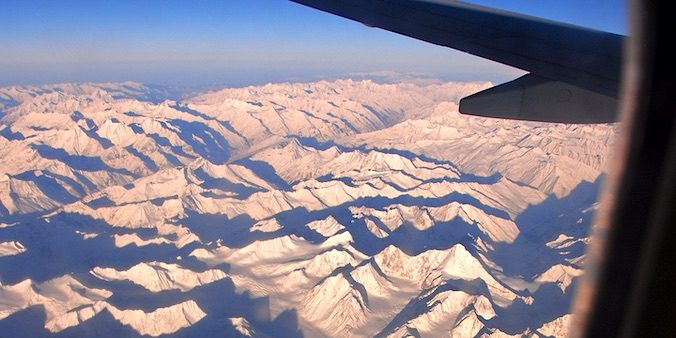
Flight to Leh
Although the flight takes only one hour, on a clear day this no doubt is one of the most spectacular flights in Asia. After leaving the North-Indian plains and the heavily forested hills you’ll cross a number of ranges before flying over the actual glacier-clad Himalayas, the highest mountain range in the world. In winter, this is even more spectacular as even the lowere elevations are covered in thick snow. Once you have crossed the Himalayan Range, you’ll be flying over Zanskar and Ladakh. In summer you would see bare, lightly coloured mountains, tiny rivers, small hamlets of Ladakhi farms surrounded by barley fields. Now, snow will cover most of that, but not all as snowfall is much less in Ladakh than south of the Himalayan Range.
LEH in winter
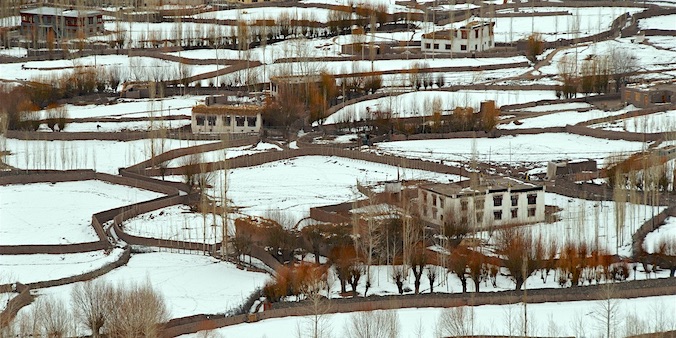
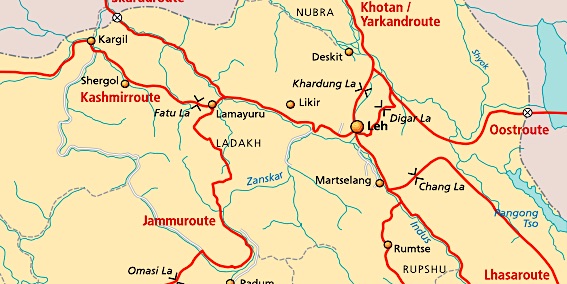
CARAVAN ROADS OF LADAKH
Walking on thin Ice
P.M.
